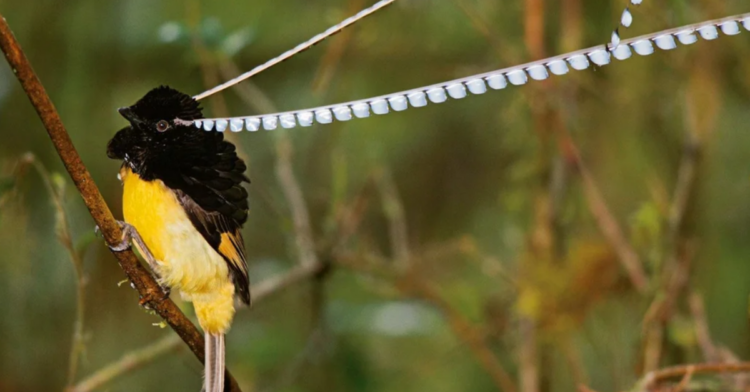No matter how many bizarre and fascinating animals we’ve seen in our lives, it’s more or less impossible to say we’ve seen them all.
After all, even those who devote their lives to studying the world’s diverse and unique creatures can still be baffled when the world reveals that something mysterious was living on it all along. After all, it’s pretty hard to know anything about an animal when you’re the first person in the world to see it.
In some cases, we can find ourselves completely failing to recognize what we’re even looking at. But even when we know what we’re looking at, we can still catch it doing something we never expected.
This seems like a very morbid sight at first glance, but it’s really just a kind of fungus.

What we’re looking at is the Xylaria polymorpha found throughout North America and Europe, but you might know it better as the “dead man’s fingers.”
Yeah, it’s not too hard to see how it got that name.
We may have seen flying fish in action, but it’s a very different feeling to look at one up close.

Although it doesn’t flap those wings so much as glide with them, it’s still pretty surprising to see that the flying fish actually has them. They look like they’ve either been glued on or photoshopped in, but they’re real.
I can’t exactly speak to its actual temperament, but doesn’t the red-shanked douc look oddly polite?

Unfortunately, the World Wildlife Fund has reported that this species of monkey and its gray-shanked and black-shanked cousins are all endangered.
It’s found in Vietnam and Laos, but its habitats are disappearing due to deforestation. To make matters worse, its also often hunted despite laws prohibiting that activity.
It’s hard not to notice how large the mouth of the basknig shark is, but it gives us a good idea of how massive the animal itself is.

According to the Florida Museum , it’s actually considered the second-largest fish in the world and tends to grow to about 40 feet in length and weigh five tons.
Despite its size, it’s considered passive when humans and boats are around and isn’t known to be threatening to either.
This unusual fellow is known as a Tonkin snub-nosed monkey and it can be found in northeastern Vietnam.

According to the International Union for Conservation of Nature , however, the unfortunate truth is that it can’t be found very easily as only about 150 of them left in the world.
Whether you call this a by-the-wind-sailor or a Velella velella, it’s actually not quite accurate to say that it’s just one creature.

According to the University of California in Santa Barbara , each specimen is actually a colony of little jellyfish like creatures that release a toxin to catch plankton, but they aren’t known to be particularly dangerous to humans.
Although it’s pretty evident how powerful gorillas and baboons can be, that’s not to say they’re the only primate that can mess you up.

As we can see here, a chimpanzee’s hair does a surprisingly effective job of disguising just how muscular the creature is.
If you head down to Cameroon, it’s good to know that it’s not impossible for you to run into what looks like a very painful cricket to touch.

However, it’s also pretty unlikely that you’ll encounter the Cosmoderus Femoralis because it’s rare enough that not a lot of information seems to be publicly available about it.
This litttle fella is about as mysterious as it is adorable, which probably explains why it’s called a piglet squid.

As Livescience explained , the reason why he’s so puffy-looking is because the mantle is full of ammonia to help control its buoyancy.
It’s a chemical we have to be careful with, but the piglet squid clearly doesn’t have that problem.
These raccoon dogs may not look so special, but they stand out in the way they’ve managed to adapt to an environment that most of us wouldn’t want to spend much time in.

As Newsweek reported , the radiation around Chernobyl has shown some evidence of decreasing the fertility of nearby birds, but the raccoon dogs are just as abundant in the area as ever.
It hasn’t seemed to have affected the populations of gray wolves, red foxes, and Eurasian boars in the region either.
Not only is this hognose snake a beautiful shade of pink, but it’s about as adorable as it looks.

According to the government of Ontario, Canada , this snake is known for trying to bluff predators into thinking it will bite them.
If they don’t fall for it, it just plays dead instead. It’s completely harmless.
Although it’s a sea-cucumber, this odd creature is commonly known as the “headless chicken monster.”

As NBC News reported , these creatures will usually hang around the ocean floor and eat algae, but this one in particular is rarely seen as it only seems to appear in the Gulf of Mexico and off the eastern coast of Antarctica.
It’s hard to recognize some of them, but this is just a sample of the staggering varieties of potatoes you can find in Peru.

According to The Guardian , the Potato Park in Cusco holds about 1,367 potato variations that are all grown in a patchwork of small plots.
It makes a lot of sense that Peru would be home to so many potatoes as that’s where they were first domesticated about 7,000 years ago. Even the Incan Empire isn’t anywhere near that old.
There’s a big difference between knowing the Pied-billed Grebe eats frogs and actually seeing one go through with it.

That frog looks like it would be way too big for this bird’s throat, but it was apparently able to get it down without too much trouble.
This is a yellowhead jawfish and in its mouth are all of the eggs it’s supposed to look after.

We know that how involved a male is in childcare varies a lot from species to species, but jawfish must be pretty attentive dads because this doesn’t look very comfortable.
No matter how resilient trees demonstrate themselves to be, there’s always a chance that they’ll find a way to surprise us.

For instance, the fact that this tree had half of its trunk gnawed away by a beaver didn’t seem to stop it from standing and apparently thriving.
I can only wonder what interrupted the beaver.
The king of Saxony bird of paradise may stand out in a way that lives up to its fancy name, but it’s only unusual for us.

According to the Australian Museum , this is a very common bird in New Guinea that pretty much just likes to eat fruit and mate.
It’s known to mate at any time of year, but seems to do it the most from July to February.
It probably won’t be much of a surprise to learn that this fearsome insect is called the devil’s flower mantis.

According to the Louisville Zoo , this is not only because of its ferocious nature (again, not a surprise), but also due to the fact it’s known to disguise itself as a flower.
As we’ve discussed before, there’s a significant difference between understanding that a flying squirrel glides and actually seeing it go.

It’s pretty wild to see it act like a big kite, but this sight also makes its red and white pattern look more dazzling.
Maybe it’s just because of all the Froot Loops commercials, but I wouldn’t have expected a toucan to eat a bat.

However, that’s unmistakably what this majestic bird is about to do and it certainly has a big enough beak to deal with the critter.
















































